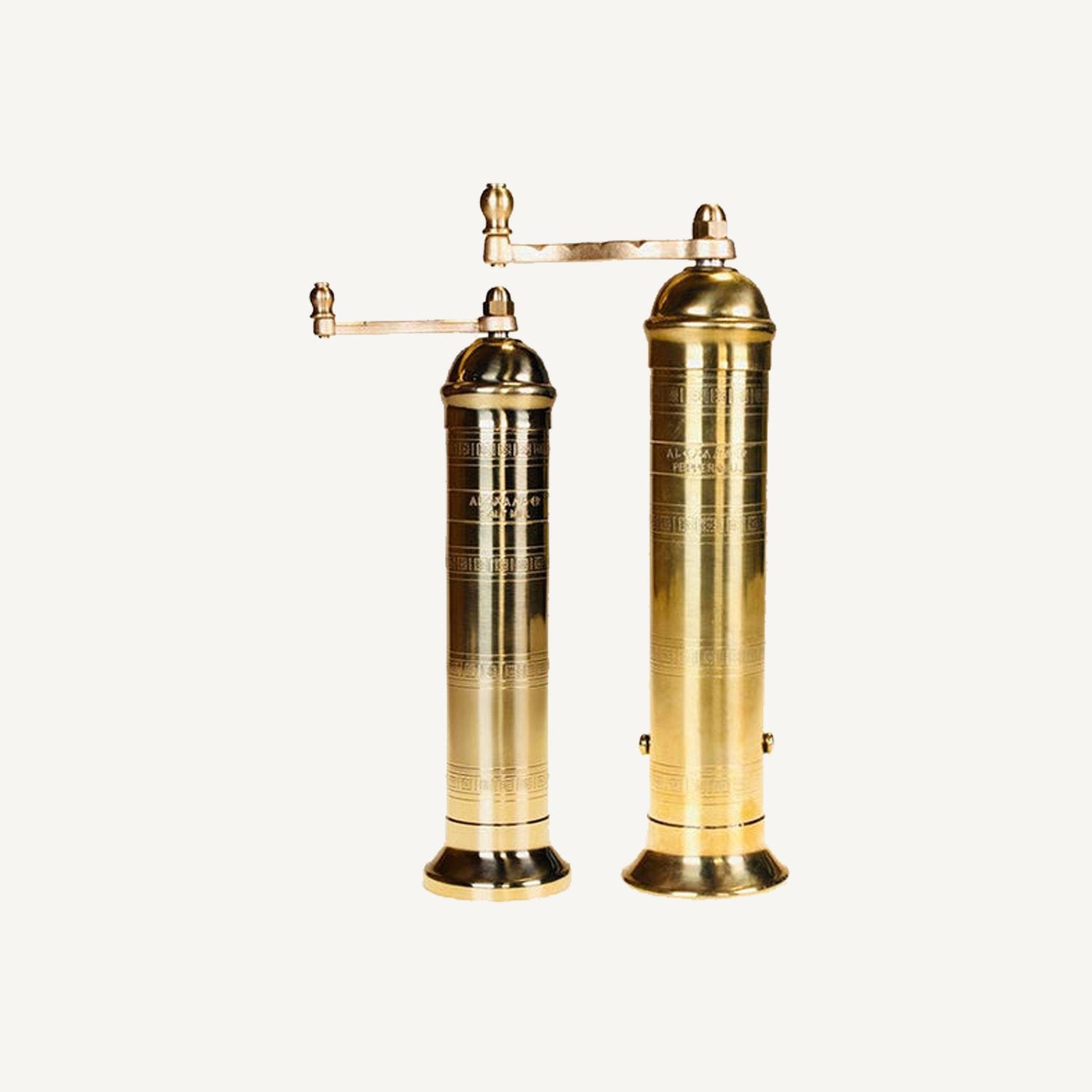Handmade of solid brass
Material thickness of 1mm
Equipped with a solid, cast grinder
Made in Greece
Your mill will need some regular care and maintenance to keep it in good working order. It's important to clean the mill regularly, to keep it's contents fresh and avoid exposure to moisture.
Never wash the mill in water or in the dishwasher!
Instructions for Use:
Only use the mill for grinding ingredients it was intended for. Pepper mills are designed for grinding standard peppercorns. It is not recommended to grind peppercorns or spices with a soft core in these mills. Never grind salt in a mill intended for pepper, as this will corrode the metal mechanism. Slat mills have a food safe plastic grinding mechanism and are suitable for grinding dry sea salt or rock salt. Avoid "wet" or "grey" sea salt, or salt flakes as these will clog the mechanism. To get the best out of your Salt Mill you should use dry coarse salts, with a diameter of 4mm.
Inserting Ingredients:
Mills are filled from the top by unscrewing the top knob and removing and replacing the handle and lid. It's a good idea to refresh the contents of the mill regularly to avoid them becoming stale and absorbing moisture over time which will clog the mill. When refilling salt mills, beware of any salt residue that may stick between the grinder and its body. This can cause severe oxidization. Before replacing the grinder cap, clean the area with a small brush and dry cloth.
Adjusting the Grind:
Adjust by turning the knob at the top. Tighten the knob clockwise for a finer grind. All other pepper mills may be adjusted by adjusting a screw to the underside of the grinding mechanism at the bottom of the mill.
Cleaning Internal Parts:
NEVER WASH THE MILL IN WATER OR IN THE DISHWASHER!
Regularly cleaning will help maintain your mill in good working condition. Take the opportunity to give the mill a clean whenever you've taken it apart to refill the contents. The mills are designed to be easily disassembled for maintenance. Take the mill apart completely to remove any contents and thoroughly clean all parts. After removing the top knob and handle, the grinding mechanism and central shaft should also be removed from the body of the mill. Pepper mill can be disassembled by removing screws to the underside of the mill. Other pepper mills have screws at the sides of the mill which need to be removed to take out the grinding mechanism. Salt mills have a different plastic grinding mechanism held in by screws to the underside of the mill, which can be removed to remove the plastic parts. Salt mills also have a black plastic internal lining to the main body of the mill which cannot be removed. Once the mill is disassembled, give all the parts a good clean with a small brush and dry cloth. Only the plastic parts of the salt grinders can be clean separately in water to dissolve any clogged salt. All parts should be thoroughly clean and dry before reassembling. Any corrosion occurring inside the mill should be controlled while the mill is disassembled for cleaning. see below for more information on controlling corrosion.
Cleaning and Polishing the Exterior:
Brass and copper are naturally resistant to corrosion, but like all metals, they will inevitably oxidize and change in appearance with touch and with use and through exposure to moisture and oxygen in the air. This process is part of the nature of the metal and brings with it an attractive patina of use. The change in appearance is unpredictable and might occur in different ways on different parts of the mill. If you prefer a bright polished look, most of the mills can be polished with an ordinary metal cleaner (Brasso) using a soft cloth to polish the outside of the mill. Please note however- some of the pepper mills are supplied with a lacquer coating which is baked on and provides resistance to exterior tarnishing, but which should not be cleaned or polished using metal cleaning product. Mills with a lacquer may be wiped clean with a damp cloth then dried.
Controlling Corrosion:
Care should be taken to avoid exposure to moisture. Never wash or submerge the mill in water and do not wash in the dishwasher. Store the mill in a cool dark place. Exposure to moisture or humid environments may lead to a more extreme corrosion scubas bright green-blue to grey coloration, which are best removed. Corrosion may also sometimes occur inside the mill or between metal parts for example between the lid and body of the mill, which can be checked and cleaned when refilling the contents. There are a variety of proprietary metal cleaners on the market suitable for cleaning brass and copper. A scourer or fine steel wool may be used to remove more substantial corrosion, but may also scratch the metal. We've found a vinegar bath to be quite effective in removing rust and brightening up the metal surface. Be sure to dry thoroughly after cleaning with a soft dry cloth. Please Note! - These methods are suitable for use on uncoated metals and should not be used on mills supplied with a lacquer coating.
For more information:
https://www.brasspeppermill.com/wp-content/uploads/2022/01/Alexander-Handcrafted-Mills-Guide.pdf
